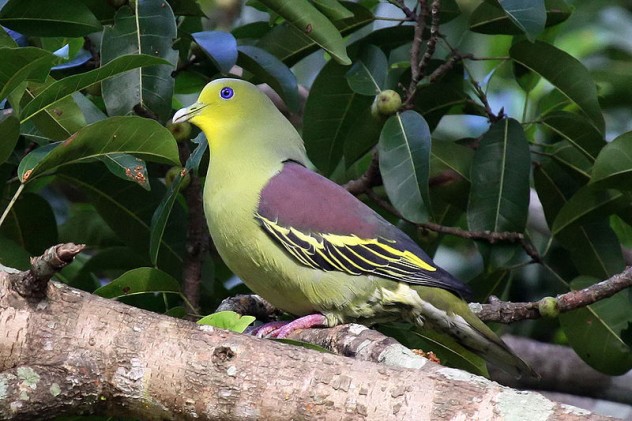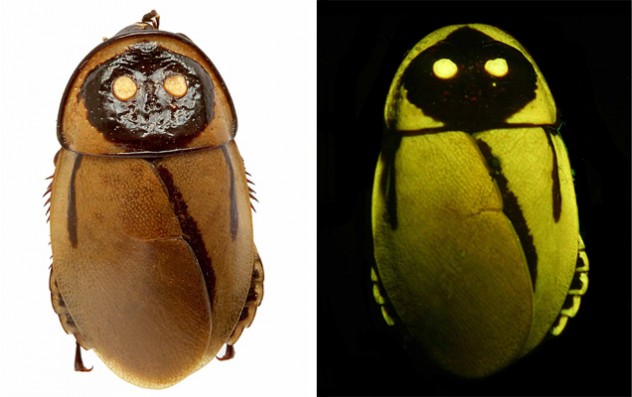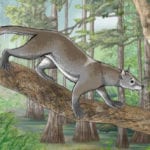 Mysteries
Mysteries  Mysteries
Mysteries  History
History 10 Surprising Stories About the Texas Rangers
 Humans
Humans 10 Philosophers Who Were Driven Mad by Their Own Theories
 Miscellaneous
Miscellaneous 10 Video-Game-Worthy Weapons and Armors from History
 Weird Stuff
Weird Stuff 10 Psychics Who Accurately Predicted Wartime Events
 The Arts
The Arts 10 Pieces of Art Inspired by a Broken Heart
 Health
Health 10 Science Fiction-Sounding New Medical Treatments
 History
History 10 Surprising Facts About the Father of Submarine Warfare
 Space
Space Ten Astonishing New Insights into Alien Worlds
 Weird Stuff
Weird Stuff 10 Bizarre Summer Solstice Rituals Still Practiced Today
 Mysteries
Mysteries Top 10 Haunting Facts About the Ghost Ship MV Alta
 History
History 10 Surprising Stories About the Texas Rangers
 Humans
Humans 10 Philosophers Who Were Driven Mad by Their Own Theories
Who's Behind Listverse?

Jamie Frater
Head Editor
Jamie founded Listverse due to an insatiable desire to share fascinating, obscure, and bizarre facts. He has been a guest speaker on numerous national radio and television stations and is a five time published author.
More About Us Miscellaneous
Miscellaneous 10 Video-Game-Worthy Weapons and Armors from History
 Weird Stuff
Weird Stuff 10 Psychics Who Accurately Predicted Wartime Events
 The Arts
The Arts 10 Pieces of Art Inspired by a Broken Heart
 Health
Health 10 Science Fiction-Sounding New Medical Treatments
 History
History 10 Surprising Facts About the Father of Submarine Warfare
 Space
Space Ten Astonishing New Insights into Alien Worlds
 Weird Stuff
Weird Stuff 10 Bizarre Summer Solstice Rituals Still Practiced Today
10 Animals Known Only From A Single Specimen
A glow-in-the-dark cockroach, an omen of death from Maori legend, and a parasitic wasp named after a controversial pop singer may not seem to have much in common, but they are among the species known to science only by their holotype. In other words, only a single specimen of these creatures is known to exist. Such animals are not as rare as might be expected—The Encyclopedia of Life lists 61 such species. Some of the animals are likely lost forever, though others may still exist. The list does not include hybrids bred in captivity such as the Indian/African Elephant hybrid.
(Note: Images on this list are intended to be illustrative or are photos of near relatives, but obviously are not actual photos of the exceedingly rare animals in question.)
10 Liverpool Pigeon

The origin of the pigeon is mysterious as there was no locality or collection data with the specimen, and much of what is written about it is guess work. Also known as the spotted green pigeon, it gained its more common name from the museum it is housed in. The bird’s diminutive wings suggest it lived on a small island with few natural predators, and its green color suggests it was a forest dweller. Tahiti was a popular destination for collectors at the time, so this is a possible place of origin. Debate is still ongoing as to whether the pigeon is the mysterious titi—described by Tahitians as a green and white spotted bird—or if titi is just a general name for birds of this genus. Early observers of the bird, Rothschild among them, suggested a link with the Nicobar pigeon—said to be the only living relative of the dodo—but once again this is open to debate.
The pigeon’s history once reaching England is better known. The 13th Earl of Derby purchased the bird from a Major Davies, and it formed part of his massive collection at Knowsley Hall in Merseyside. The collection also included the holotype of the night parrot and one of only two known specimens of the New Caledonian Nightjar, as well as many living animals and birds. When the Earl died in 1851, his collection was bequeathed to Liverpool and it became the foundation of The World Museum in that city.
The bird was most recently put on display in the museum in 2008, the same year it was declared extinct by birdlife international. Originally, two specimens of this bird were collected, but as one was lost shortly afterwards and before it could be described, it still fits the criteria for this list.
9 New Ireland Stingaree

It is somewhat ironic that a number of these species have more names than specimens. The New Ireland stingaree, aka the black-spotted stingaree, is known to science only from a juvenile male found in the Bismarck Archipelago of New Ireland, Papua New Guinea during an expedition between 1822–25. Its Latin name, Urolophus armatus, means “armed.” This refers the fact that this stingaree is unique among stingrays in having dermal denticles, which are tough scales similar to teeth that provide protection against predators.
The creature was taken to a museum in Paris and described by Mueller and Henle in 1841, but it is not recorded where it is now. Scientists have requested any further specimens caught should be donated to museums. As the holotype is a juvenile, much about the species—such as longevity and maximum size at maturity—remain unknown. There is also insufficient information as to its current status, as the location it was observed is one of the least frequently surveyed areas on earth, though surveys in adjacent areas have not produced any further specimens.
It is not known if the fish is extinct or if its habitat requirements are within a very narrow geographic range. If it is extinct, it is not through overfishing as there is little fishing activity in its locality. However, oil and gold exploration in the general vicinity could be a potential threat to the wildlife of the area.
8 Mauke Starling

When naturalist Andrew Bloxam of HMS Blonde shot a kingfisher, a pigeon, and starling on a short visit to Mauke in the Cook Islands in 1825, it is unlikely he realized the enduring mystery the starling would cause.
The skin of this specimen, which is housed in The Natural History Museum in London, was labeled 12.192 and informally referred to as the “mysterious starling.” For a long time, no one knew the bird’s history, and it was erroneously believed to have been collected on Cook’s second voyage. Mislabeling and renaming of the specimen added to the confusion. In 1986 Storrs Olson, an American ornithologist at the Smithsonian, gained access to Bloxam’s original diary. He noted that Bloxam’s descriptions and measurements matched the surprisingly well-preserved specimen and the pieces of the puzzle were finally put together. Today, the bird is recognized as a distinct, valid species.
Ornithologists did not visit Mauke again until the 1970s, and there were no further recordings of any bird matching the starling’s description. It is considered extinct, thought to be caused by predation by introduced rats, which were common on the islands even in Bloxam’s day. It is not known what happened to the kingfisher and pigeon, which were shot, though the latter is thought to have been the only example of the now extinct Mauke fruit dove.
7 Delcourt’s Giant Gecko

The largest extant gecko is the New Caledonian giant forest gecko, which grows to 36 centimeters (14 inches). At 62 centimeters (2 ft) long, Delcourt’s giant gecko, known only from one incomplete taxidermy mount, is almost twice as large.
It was first recognized as a new species in 1986 and fittingly named after the herpetologist at The Marseille Museum of Natural History, where it was on public display. Alain Delcourt first took serious notice of the gecko in 1979. Until then, it had resided in the museum for at least a century being viewed by visitors unaware of its significance. There was no locality or collection data with the mount, but it is believed to have been collected between 1833 and 1869. No museum records survive from this time, so this seems a plausible reason for the lack of documentation. However, it could date from as early as 1819 to when the museum opened to 1902, when record keeping became more stringent.
Scientists agreed its point of origin was Pacific. As the mount was in a French museum, New Caledonia was first suggested as the gecko’s habitat. However, its resemblance to the brown forest gecko makes New Zealand a more likely country of origin. It is here that cryptozoologists might take interest. The giant gecko bears a remarkable resemblance to the kawekaweau of Maori folklore, which was said to be about 62 centimeters (2 ft) long, “as thick as a man’s wrist,” and a rusty brown color. They were also said to be omens of death. Tales of these creatures date back to Captain Cook’s travels to the area in 1777, and while a couple of giant reptiles were captured at this time, they were lost. We do not know if they were the kawekaweau, the giant gecko, or something else entirely. In 1870, a Maori chief is said to have seen a live one and killed it. There are no further sightings until the 1990s.
The mount was briefly sent back to New Zealand as part of the celebrations for the 150th anniversary of the signing of the Treaty of Waitangi. Respected biologists, such as Dr. Anthony P. Russell and Dr. Aaron M. Bauer, believe the two creatures to be the same. Until another specimen is found, however, we will never know if they are right.
6 Percy Island Flying Fox

As the name suggests, the holotype of this bat was found in the Percy Island group off Queensland, Australia. Captain Denham of HMS Herald observed the animal in the latter half of the 19th century, but reports differ as to the exact year. The date of its collection is not the only area that scientists disagree on. Reports from the 19th century state that the bat was plentiful on these islands, yet others are uncertain if the specimen originated there, or even if it is a distinct species. Some scientists believe the creature, also known as the dusky flying fox, was a windblown small flying fox from The Louisiade Archipelago. The Solomon Islands have also been put forward as a possible area of origin of the species. Coincidentally, another bat also known from a single specimen, the Nendo tube-nosed fruit bat, did originate from the Solomon Islands.
The disagreements over the animal’s origin and taxonomic status have resulted in it being removed from the Convention on International Trade in Endangered species in 2001. The Australian government no longer recognizes the bat as a valid species.
There were unconfirmed reports in the early 1990s that a colony of the bats was living on nearby Akens Island, but searches proved fruitless. The only known dusky flying fox is a taxidermy mount in The British Museum.
5 Luchihormetica Luckae

Although this cockroach is referred to as one of the top new discoveries of 2012, it was actually studied and formally described using a single specimen collected in 1939.
The cockroach is rare among land animals in being luminescent. Rarer still, this bioluminesence is not used to communicate or attract a mate as it is with fireflies, but to mimic the toxic click beetle to avoid being preyed on. The species is also the only example of asymmetrical bioluminesence. This visual anomaly gives the cockroach the appearance of a Star Wars character.
By using technology not available 70 years ago, scientists were able to scan the adult male cockroach and came to the conclusion that luminescent land animals are much younger than their marine counterparts.
Sadly, its seems this particular cockroach is not as hardy as people imagine them to be. The part of Ecuador where the cockroach was found was destroyed by the Tungurahua volcano in 2010. This—combined with the ever growing urbanization of the area—means scientists fear the cockroach is already extinct. So, unless other specimens are found accidentally, the strangely beautiful insect will be truly one of a kind.
4Golden Moles

There are 21 species of golden mole, many of which are endangered. Despite their name and appearance, they are only distantly related to true moles.
Due to their subterranean nature, they have proved rather elusive to science, two species particularly so. The Somali golden mole (Calcochloris tytonis) is known only from a partial skeleton found in an owl pellet in 1964. Visagie’s golden mole (Chrysochloris visagiei) is a bit more tangible. The type specimen was found in 1950 on an estate in Gouna in South Africa and named after the landowner. As no further specimens have been found, despite several field trips to the area, there is some suggestion that there was an error in recording provenance or that the creature was transported there naturally by floodwaters from the Renoster River. The adjacent areas are deemed unsuitable habitats for the burrowing animals, so perhaps these theories are true.
As the type locality has changed dramatically since 1950 due to agriculture, scientists believe the mammal has likely become extinct. However, Van Zyl’s golden mole (Cryptochloris zyli) was also known from a single specimen collected in 1938, until a second was found in 2003.
3 Cyclops Long-Beaked Echidna
(Sir David’s Long-Beaked Echidna)

Unlike many of the other creatures on the list, scientists are hopeful that this animal still survives and it is listed as critically endangered rather than extinct by IUCN. It is named after the respected British naturalist Sir David Attenborough and known only from a slightly damaged specimen, which was found in 1961 in the Cyclops Mountains of Papua New Guinea by Dutch explorers. The creature now resides in Leiden Natural History Museum in the Netherlands. It is the smallest breed of echidna, all of which are threatened species, and is believed to be endemic to one mountain peak in the area.
In 2007, researchers discovered fresh tracks and feeding holes—or “nose pokes”—made by the creature. Local hunters also state they have they have seen—and most likely eaten—the animal as recently as 2005. As the feeding holes were found at a much lower level than where the holotype was found, scientists are hopeful there are more specimens higher up the mountain. However, no further specimens or partial specimens have been found.
The animal has subsequently been given special attention by EDGE to raise awareness it. There is also ongoing work with locals to persuade them to not hunt and eat them. This conservation program launched by London Zoological Society aims to protect genetically distinct animals and includes nine other species, including the Yangtze River dolphin.
2 Nechisar Nightjar

This species takes being known from only specimen to extremes, as it is known from a single wing—hence its Latin name, solala, meaning “only a wing.” Unlike the other birds on this list, it did not meet its demise at the end of a Victorian explorer’s gun, but was likely hit by a car in the Nechisar Plains, Ethiopia. The wing was taken from the decomposing body and brought to the Natural History Museum in London.
It is believed to be from female or a juvenile male and is described as being unlike any other nightjar. The wing has large buff spots and a buffish-white band. It is believed to be endemic to the Nechisar plains and is considered vulnerable due to its small range. The National Park the plains are situated in are no longer protected the way they were in the 1980s and early 1990s, and illegal settlers in the area actually caused a fire that resulted in severe damage to the habitat in 1998.
However, as with the previous entry, there is hope that more specimens can be found. In 2009, a number of bird watchers traveled to the region of Ethiopia where the wing had been found. They liken their adventures to those of Victorian times, but they only wanted to shoot the bird with a camera. The explorers reported seeing a bird with similar coloring to the nightjar and remain convinced they saw one, but with only blurry photographs as proof, the enigmatic “only a wing” nightjar remains true to its name.
1 Lady Gaga Braconid

This tiny insect hit the headlines in 2012 and proved controversial not just due to its name, but also the methods used to identify it. The female specimen was found in Chae Son National Park in Thailand during a three-year survey of 25 Thai national parks. Hundreds of other species were found in the survey, and they were all described using “turbo taxonomics”—a type of DNA barcoding which provides speedy identification for newly discovered species. Previously, formally describing species could take decades, but this new method—which uses a short DNA sequence from the genome—streamlines the process. The system has its supporters and detractors.
As for the 5mm (.1 in) insect itself, scientists have discovered it is a parasitic wasp which likely lays its eggs inside its prey’s head, which devour their prey from the inside out upon hatching. Lady Gaga does not seem to have commented on this dubious honor. The name chosen for the wasp has left many people scratching their heads, as there does not seem to be an obvious reason for the choice. Some commentators have declared the name not “nerdy” enough, while others see the humor and suggest it is a way of encouraging a younger crowd to taxonomy. Publicity seems to be the most likely reason, and as it is this creature and not one of the 178 others which hit the headlines, it seems to have worked.
This would not be the last time Lady Gaga would give her name to scientific breakthroughs. In October 2012, 19 species of fern were named after Ms. Germanotta. In this case, scientists defended the name, stating that the singer’s work promoting gender equality makes her an appropriate person to give her name to the gender-changing ferns.
Andrea G is a regular Listverse reader. Despite a phobia of taxidermy, she has an interest in extinction and cryptozoology, so compiling this list was both a pleasure and a nightmare.








